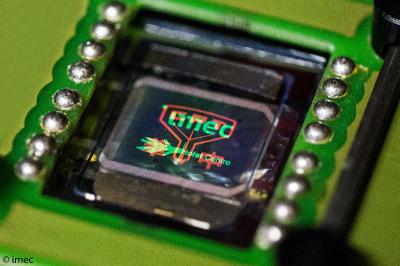Chunghwa Picture Tubes (CPT) together with the world-leading research and innovation hub in nanoelectronics and digital technologies imec and Holst Centre, showcase an ultra-high resolution display realized by photolithography patterning of organic light emitting diode (OLED) arrays. The results pave the way to cost-effective manufacturing of fine, side-by-side pixels in OLEDs, and will be presented at the annual International Smart Display and Touch Panel Exhibition, Touch Taiwan, in Taipei, Taiwan ROC, Sep 20 – Sep 22.
 |
|
(Image: imec) |
High quality displays are at the core of modern, connected society, with mobile screens enabling and enhancing an ever-increasing number of daily appliances. Active-matrix organic light-emitting diode (AMOLED) displays, with discrete light emitting pixels, are steadily growing, not only in market share, but also in achievable resolution, brightness, size and lifetime. To continue the advancement of this technology, imec together with its program partners are researching a cost-effective manufacturing method for OLED arrays featuring fine pixels. Pushing the pixel density beyond 1000 ppi is a necessary step for implementation of next-generation displays, especially for virtual and augmented reality.
CPT and imec have verified that a novel photolithography process can allow for ultrafine OLED patterns. The proposed technique does not require using fine-metal masks to structure thermally evaporated OLED stacks (“FMM-free”). One of the main challenges when applying standard photolithography is the fragility of the organic materials for the photolithography chemicals. To circumvent this issue, imec and CPT have used an i-line, chemically amplified photoresist system in a process flow dedicated to OLED stacks. Apart from ultra-high resolution, other benefits of photolithography include high aperture ratio, large substrate size compatibility and good yield control.
The proof-of-concept is a passive display with 1400x1400 pixels (1.96 megapixel) of side-by-side, orange and green OLEDs. The sub-pixel pitch of 20 μm results in the equivalent resolution of 1250 ppi. Uniform electroluminescence is demonstrated with the possibility to light up each color separately. Moreover, preliminary lifetime investigation shows operation of each color after patterning for a few hundred hours at more than 50% of the original brightness.
“Our goal is to identify and explore technology bottlenecks in the extremely competitive and fast-paced display industry. With research activities spanning from material and device science, through design, fabrication and integration all the way to tech transfer, we make use of our semiconductor and thin-film background,” stated Paul Heremans, program director of thin-film electronics at Holst Centre/imec. ”The collaboration with CPT enables us to improve the manufacturability readiness level of the OLED photolithography patterning method. This will enable production of ultra-high resolution OLED displays for next-generation user interfaces. We are very happy to have the possibility to explore this exciting technology route with our innovative partners.”





 CN
TW
EN
CN
TW
EN






